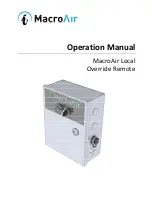
EN |
29
FANS v2024.1
Fig. 5.5.25 Mounting
5.6. CONNECTION OF THE AIR DUCTS
•
The connected air ducts must not be bent and must be fixed separately.
•
Make sure that the fans may not be accessed through air duct heads. Otherwise, a protective grid should be installed. You may choose the grid
from the range of products provided on our website https://select.salda.lt.
•
Do not reduce the diameter of the piping near the air inlet or exhaust ducts. If you want to reduce the airflow speed in the system, also to reduce
pressure and noise level, you can increase the diameter.
• In order to reduce the level of noise in the air supply system, install silencers (see the chapter on air supply system installation).
•
In order to reduce air loss in the system, the air ducts and profile components should be of class C or higher. The catalogue of the above-men
-
tioned items can be found on our website https://select.salda.lt.
• External air and exhaust system piping should be isolated in order to prevent heat loss and condensation.
•
We recommend to maintain a distance of up to 8 meters between air intake and air exhaust ducts. The air intake point should be installed away
from potential air pollution sources.
• When installing air ducts next to the ventilation equipment, brackets must be used. They suppress vibrations and assure secure installation of
the various system parts. The necessary brackets can be found in our catalogue or on our website https://select.salda.lt.
• Air ducts are often mistakenly connected in an inappropriate location. The ventilation units bear the labels indicating the correct air duct connec-
tion layout. Before starting up the system, carefully check if all related works have been performed properly.
For flange diameters see chapter
.
5.7. CONNECTION OF THE UNIT TO THE ELECTRIC NETWORK
•
Supply voltage to the unit must be connected by a qualified specialist following the manufacturer’s instructions and applicable safety guidelines.
•
The unit’s power network voltage must correspond to the electro-technical specifications of the unit indicated in the technical decal.
•
The unit’s voltage, power and other technical specifications are provided in the unit’s technical decal (on the unit casing). The unit must be
connected to the voltage plug socket of the grounded power network in accordance with the applicable requirements.
• The unit must be earthed according to electrical equipment installation regulations.
•
Using extension wires (cables) and power network plug socket distribution devices is not allowed.
•
Prior to carrying out any ventilation unit installation and connection works (before the unit is commissioned), the unit must be disconnected from
the power network.
•
After installation of the fan unit, the power network plug socket must be accessible at any time. If the unit is equipped with circuit breaker, dis
-
connection from the power network is performed through the circuit breaker (by disconnecting phase poles and neutral).
•
Before it is connected to the power network, the unit must be carefully checked for any damage (operation, control, and measurement nodes)
made during transportation.
•
The power cable can be replaced only by a qualified technician, after the evaluation of the rated power and current.
•
For power connection of the exact fan unit, see section
The manufacturer does not assume any liability for personal injuries and property damage due to non-conformance with the
provided instructions.
















































